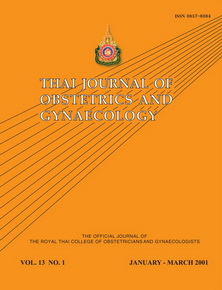Echovist-200 as an Ultrasound Contrast Medium for Hysterosalpingocontrast Sonography
Main Article Content
Abstract
Objective To assess image quality and tolerance of Echovist-200 as a
hysterosalpingocontrast medium.
Design Open clinical trial
Setting Chiang Mai University Hospital
Subjects Infertile women who required evaluation of tubal or uterine abnormalities.
Intervention The uterus and fallopian tubes were assessed by both plain ultrasound and
hysterosalpingocontrast sonography using Echovist-200.
Main outcome measures The primary outcome variable was the image quality of the internal
genitals after the use of Echovist-200. Secondary variables included the presence or
absence of uterine and tubal abnormalities, pain and other adverse events.
Results Fifty patients were enrolled into the study. The mean age was 32.7 ± 4.2 years,
the mean volume of Echovist-200 used was 10.9 ± 3.9 ml and the mean duration of
examination was 6.8 ± 3.0 minutes (mean ± standard deviation). Seven insertions of
catheter were problematic and one had balloon rupture. Image quality after instillation of
Echovists-200 was rated as good in all cases. Both tubes were patent in 34 patients
(68%), patent on one side in 13 (26%), occluded bilaterally in 2 (4%) and 1 tube was
not assessable (2%). Forty eight patients (96%) experienced a total of 58 adverse
events. Pelvic pain was present in 24 of 50 (48%).
Conclusion The use of Echovist-200 in HyCoSy enhances image quality for the evaluation
of the internal genitals. HyCoSy showed good diagnostic performance in the evaluation
of the tubes and uterus. The procedure was safe with minor adverse events.
hysterosalpingocontrast medium.
Design Open clinical trial
Setting Chiang Mai University Hospital
Subjects Infertile women who required evaluation of tubal or uterine abnormalities.
Intervention The uterus and fallopian tubes were assessed by both plain ultrasound and
hysterosalpingocontrast sonography using Echovist-200.
Main outcome measures The primary outcome variable was the image quality of the internal
genitals after the use of Echovist-200. Secondary variables included the presence or
absence of uterine and tubal abnormalities, pain and other adverse events.
Results Fifty patients were enrolled into the study. The mean age was 32.7 ± 4.2 years,
the mean volume of Echovist-200 used was 10.9 ± 3.9 ml and the mean duration of
examination was 6.8 ± 3.0 minutes (mean ± standard deviation). Seven insertions of
catheter were problematic and one had balloon rupture. Image quality after instillation of
Echovists-200 was rated as good in all cases. Both tubes were patent in 34 patients
(68%), patent on one side in 13 (26%), occluded bilaterally in 2 (4%) and 1 tube was
not assessable (2%). Forty eight patients (96%) experienced a total of 58 adverse
events. Pelvic pain was present in 24 of 50 (48%).
Conclusion The use of Echovist-200 in HyCoSy enhances image quality for the evaluation
of the internal genitals. HyCoSy showed good diagnostic performance in the evaluation
of the tubes and uterus. The procedure was safe with minor adverse events.
Article Details
How to Cite
(1)
Uttavichai, C.; Sreshthaputra, O.; Sreshthaputra, R.; Vutyavanich, T.; Wongtra-Ngan, S.; Jongusuk, P. Echovist-200 as an Ultrasound Contrast Medium for Hysterosalpingocontrast Sonography. Thai J Obstet Gynaecol 2017, 13, 33-37.
Section
Original Article


